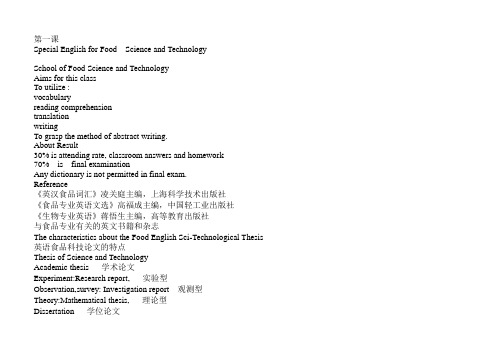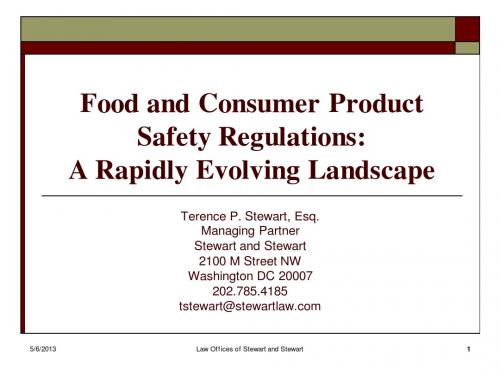《食品专业英语》PPT课件
食品专业英语PPT

02
Food related English vocabulary
Food classification vocabulary
第一季度
第二季度
第三季度
第四季度
Fruit
A rope editable fruit, typically containing seeds Fruit is often sweet and juicy
Course objectives and learning methods
• Course objectives: The main objective of Food Professional English courses is to provide learners with the language skills and knowledge required for effective communication in the food and coverage industry Learners will be able to understand and use specialized vocabulary, understand industry specific concepts and practices, and be able to participate in discussions and collaborate with colleagues in the industry
• Learning methods: To achieve these objectives, Food Professional English courses often use a combination of traditional and innovative teaching methods These may include classroom instruction, case studies, simulations, group discussions, and online learning resources Learners are also resourced to engage in real world projects and internships to gain practical experience in the field
食品专业英语课件内容

第一课Special English for Food Science and TechnologySchool of Food Science and TechnologyAims for this classTo utilize :vocabularyreading comprehensiontranslationwritingTo grasp the method of abstract writing.About Result30% is attending rate, classroom answers and homework70% is final examinationAny dictionary is not permitted in final exam.Reference《英汉食品词汇》凌关庭主编,上海科学技术出版社《食品专业英语文选》高福成主编,中国轻工业出版社《生物专业英语》蒋悟生主编,高等教育出版社与食品专业有关的英文书籍和杂志The characteristics about the Food English Sci-Technological Thesis 英语食品科技论文的特点Thesis of Science and TechnologyAcademic thesis 学术论文Experiment:Research report, 实验型Observation,survey: Investigation report 观测型Theory:Mathematical thesis, 理论型Dissertation 学位论文Bachelor‘s dissertation 学士论文Master‘s dissertation 硕士论文Doctor‘s dissertation 博士论文The structure of a thesisTitleAuthor‘s NameAuthor‘ s AddressAbstractIntroductionMaterials and MethodsResults and DiscussionConclusionsAcknowledgements , References and Appendix 感谢、参考文献和附录主题突出、明确,结构简洁、逻辑严谨。
食品专业英语课件lesson 11

Lesson 11 Nutrition一、WORDS1)Word`s rootmicro- very small,微小的microsoftmicrobe =microorganism 微生物,细菌micronutrient 微量营养素macro- being large, thick,大的macronutrient 常量营养素macrobiotic 可长期保存的(生命的,生物的)macroclimate 大气候-ium 表示化学元素的拉丁名字.Sodium Na Calsium CaPotassium K Aluminium Almal- badly, abnormally, inadequatelymalnutrition 营养失调malabsorption 吸收不良malnourished 营养不足2). New words in TEXTinterdependent 相互依赖dependent 依赖independent 独立interchangeable 可交换的keeping quality 耐藏性get along 过活二、TextLife are nourished by food, and the substances in food (on which life depends) are the nutrients.❑nourish v.滋养,营养❑nourishment n.营养人的生命是由食物提供营养的,而生命依赖的是食物中的营养素。
These provide the energy and building materials for the countless substances (that are essential to the growth and survival of living things).这些营养素能够为人类的生长和生存所必需的大量物质提供能量和原材料。
食品专业英语

Food borne illnesses in the U.S. cause approximately 325,000 hospitalizations and 5,0000 deaths each year Consumer product safety incidents (including injuries and death) cost the U.S. over $700 billion a year Injuries and death occur from both domestic and imported products
8/19/2011
Law Offices of Stewart and Stewart
2
Food Safety: A Global Challenge
1.8 million people died from diarrheic related diseases in 2005. Many of these deaths were a result of unsafe food or water Beijing Declaration on Food Safety (Nov. 2007):
《食品专业英语》课件

要点一
要点二
Importance
Food Professional English is essential for food professionals to expand their knowledge, improve their skills, and enhance their competitiveness in the global market It is also critical for promoting international cooperation and exchange in the food industry
Enhancing vocabulary
Reading news articles can help students expand their vocabulary and learn new words and phrases that are specific to the field of food
Summary
Understand professional vocabulary related to food storage, including refrigeration, freezing, drying, etc.
Detailed description
Food storage is the key to keeping food fresh and safe, so it is necessary to master relevant professional vocabulary. For example, "refrigerator" represents refrigeration, "freeze" represents freezing, and "dry" represents drying. In addition, it is necessary to understand the applicable scope and precautions of different storage methods.
食品专业英语课件

译文
重组DNA技术在食品和食品配料的生产应用的20年的时间 里,已经从基础研究的水平发展成商业化的地步。
Part 2 食品科技英语的阅读
Lesson 1 WHO Strategy on Food Safety
From the very beginning, development and use of genetic engineering have been accompanied by strict regulations. These regulatory requirements cover the contained use of genetically modified organisms (GMO), their deliberate release into the environment as well as the placing on the market of products containing or consisting of GMO.
B. Most developing countries are willing to be responsible for the consequence of using the new technology.
C. Most developed countries are not willing to be responsible for the consequence of using the new technology.
到目前为止,还没有关于由人们消费转基因食品所产生的 译文 负面影响的报道。然而,转基因食品的本质(伦理问题)
和发展速度引起了消费者的恐慌。
Par Strategy on Food Safety
食品专业英语.pptx

Lesson 3 Lipids
Glossary
17. cholesterol [kɔ`lestərɔl] .n.胆固醇 18. shortening ['ʃɔ:tniŋ] .n.酥油/雪白奶油 19. Emulsify [ɪ`mʌlsɪfʌɪ] (使)乳化 20.Dressing (尤指油、醋、香料等调味品混合在一起的色拉酱)
第11页/共43页
Lesson 3 Lipids
Glossary
9. Hydrocarbon [˛haɪdrə`kɑ:bən] .n. 碳氢化合物,烃 10. Glyceride [`ɡlisə˛raid] .n. 甘油酯,脂肪酸丙酯 11. lauric acid [`lɔ:rɪk, `lɔr-] .n. 月桂酸,十二(烷)酸 12.linoleic acid [˛lɪnə`li:ɪk] .n. (化)亚油酸 13.oleic acid [əʊ`liːɪk] .n. (化)油酸 14.saturated [´sætʃəreitid] . adj. (溶液)饱和的 rd [lɑ:d] .n. 猪油 16.palatability [‘pælətəbɪlɪtɪ] .n.嗜食性; 适口性;
第6页/共43页
Lesson 2 Carbohydrates
Glossary
36. Hexitol [`hekitɔl] .n.己糖醇 37. Acetylate [˛æsiti`leit] .v.乙酰化, 使乙酰化 38. Glycoprotein [˛ɡlaikəu`prəuti:n] .n. 糖蛋白 39. Chitin [`kʌɪtɪn] .n. (生化)几丁质,壳多糖,甲壳质 40. Deoxy [di`ɔksi] .adj.脱氧的;减氧的 41. Mucilage [`mjuːsɪlɪdʒ] .n.黏液;黏胶(一种多聚糖物质,为 凝胶状液体,从植物根茎、种籽等提炼,用以制药或黏合剂) 42. Cyclitol [`saikli˛tɔl] .n.环多醇
食品专业英语课件lesson 9

Lesson 9 lipids一、new wordssolubility n 溶解度,溶解性solubilize v 溶解solube adj 可溶解的solute n 溶质solution n 溶液solvent n 溶剂nonpolar solventpolar solventester n 酯⏹triester n 三酯⏹triesters of glycerol 甘油三酯glycer(o)- 甘油⏹glycerol 甘油,丙三醇⏹Triacylglycerol 三酰基甘油carboxylic 含羧基的,⏹carboxylic acid羧酸aqueous adj.水的,含水的,水成的⏹aqueo- 水合的,由水衍生的⏹aqui- 水⏹aquiculture 水产养殖cis geometry 顺式构型trans geometry 反式构型cholesterol 胆固醇saturated 饱和的unsaturated 不饱和的saturated fatty acid 饱和脂肪酸monounsaturated一元不饱和的polyunsaturated 多元不饱和的⏹mono- 单,一⏹poly- 多,聚二、textLipids are a family of naturally occurring compounds (grouped together on the basis of their relative insolubility in water and solubility in nonpolar solvents. )脂类是由相对不溶于水、可溶于非极性溶剂的天然化合物形成的一个家族。
These are naturally occurring molecules that can be isolated from cells and tissues by extraction using nonpolar organic solvents.nonpolar organic solvents非极性溶剂它们可以通过非极性溶剂的萃取作用从细胞和组织中获得。
《食品专业英语》课件

食品相关的英语单词、短语和表达
食材、菜谱、制作方法的英语表述 餐饮服务中的英语用语 食品广告和营销中的英语词汇
学习如何用英语描述食材、菜谱和不同的 制作方法,拓展你的英语词汇。
掌握在餐馆和酒店工作时常用的英语用语, 与国际客人交流更加流利和自信。
3
食品生产、加工和销售中遵循的规定
了解食品生产、加工和销售中需要遵循的规定,以确保食品的合规性和质量。
总结
1 回顾本课程的学
习内容
总结本课程中学到的 关键知识和技能,强 化学习成果。
2 总结食品学、英
语和行业术语的
3 推荐相关书籍、
网站和课程
关系
探讨食品学、英语语
分享教材和资源推荐,
言能力和行业术语之
《食品专业英语》PPT课 件
欢迎来到《食品专业英语》课程!在本课程中,我们将探索食品学的基础知 识、食品相关的英语单词和表达,以及食品行业的常用术语和标准。
课程介绍
食品学的基础知识
了解食品分类、特性以及食品加工和保存等基础知识。
食品相关的英语单词、短语和表达
学习食材、菜谱以及餐饮服务中的英语用语。
帮助学生进一步拓展
间的联系,帮助学生
知识和提升技能。
更好地掌握专业知识。
了解食品广告和营销领域中常用的英语词 汇,为将来的职业发展做好准备。
食品行业的常用术语和标准
1
食品质量管理的标准和规定
了解食品质量管理中的标准和规定,如ISO 22000和HACCP等,确保食品的安全和 质量。
2
食品安全的常用术语和法规
掌握食品安全领域中常用的术语和法规,如食品安全法和食品添加剂的使用规定。
食品专业英语课件

Special example:
通讯作者署名之后常加注“*”,并把与之相关的信息如:电话(Tel)、 传真(Fax)、邮箱号(E-mail address)等置于标题所在页的底部, 作为题注(footnotes)。
(二)摘要(abstract/summary)
摘要是对文章内容准确、扼要的表达,不加解释和评论,使读者对整篇 论文了解梗概,使其判定是否要通读全文。几乎所有公开发表的科技论 文都要有短小简洁的英文摘要,这是食品科技论文的一般要求。不仅英 文论文如此,国内大多数中文科技论文也要求提供英文摘要。
Example 22:
Example 23:
Example 24:
二、修辞特点
科技英语的逻辑性、严密性、简明性较普通英语更突出。
用词方面: 专业术语较多,一词一意,词义专业,能够准确的表达科 学含义。 专业术语词形较长,发音较难,但却广泛应用于科技论文 中。 许多词语来源于希腊语和拉丁语,前后缀出现频率较高, 还有大量缩写词,使翻译英文专业科技论文有一定的难度。 多用介词短语、分词短语、形容词短语、动词不定式短语 等,使句子结构简洁而信息容量大。
• 各刊物对标题的字数、大小写都有限制和明确规定。
Instructions to author/Information for authors/Author Guidelines 以及期刊近期的范文
• 题名字母的大小写有以下三种格式。
A. 全部字母大写。For example: DISCUSSION ABOUT THE ENVY OF CHIDREN AND THE AGED。 B. 每个词的首字母大写,但三个或四个字母以下的冠词、连词、介 词,如不在句首,全部小写。 For example: From “Go-back-to-history” to Non-history ---- A Criticism of New Historicism.(Journal of Food Science) C. 题名第一个词的首字母大写,其余字母均小写。 For example: Topographic inversion of interval velocities.
《关于食品的英语》课件

CATALOGUE
目录
Food typesFood description vocabularyFood related expressionsFood cultureFood Safety and Health
Family Meals - In China, meals are often shared with the family, and there is a strong emphasis on family unity during meals. Eating together is considered a crucial part of maintaining family bonds.
Importance of Meals - In the West, meals are considered a crucial part of the day, often served at specific times. Breakfast, lunch, and dinner are considered the main meals, with smaller meals in between.
Leaving a tip
When a customer is satisfied with the service, they might leave a tip for the waiter or waitress, saying "Here's a 15% tip for you."
Protein: Expressions related to protein include "This dish is high in protein" or "Protein is essential for building muscle."
食品专业英语课件lesson5

Lesson5 Alcoholic beverages酒精饮料一、Questions:1 In the following contents, which belong to alcoholic beverages?beer, wine, carbonated beverage , fruit juice, tea drink2. Which types alcoholic beverages can you list?The alcoholic beverages include:non-distilled beverages :非蒸馏制取的酒精饮料(酿造酒)Beers, wines, ciders苹果酒, sake日本米酒distilled beverages : 蒸馏制取的酒精饮料whisk 威士忌酒, rum 朗姆酒, brandy 白兰地酒, vodka 伏特加酒, gin 杜松子酒fortified wines 强化葡萄酒, 加度酒sherries 雪利酒, Port 葡萄牙酒,Madeira wines马德拉酒.Distilled beverages : 蒸馏制取的酒精饮料whisk 威士忌酒Produced from fermented cerealsrum 朗姆酒Produced from fermented molassesbrandy 白兰地酒Produced by distillation of winevodka 伏特加酒Produced from neutral spirits obtained by distillation of fermented molasses, grain, potato or wheygin 杜松子酒Fortified wines 强化葡萄酒, 加度酒sherries 雪利酒,port 葡萄牙酒,madeira wines马德拉酒.produced by addition of distilled spirit to wines [to raise the alcohol content to 15-20% distilled spirit 精馏酒精alcohol content 酒精含量(浓度)3 Which materials can be used to produce alcoholic beverages?Alcoholic beverages are produced from a range of raw materials but especially from cereals, fruits and sugar crops.cereals 谷类(barley, rice, corn…)fruits (wine, apple, berry, waxbe rry…)sugar crops 糖类作物(cane, beet, potato…)酒精饮料可以从一系列的原材料,尤其是谷物、水果及糖类作物中制取。
食品专业英语课件lesson 2

Lesson 2The translation of Food Sci-Technological thesis: English →Chinese食品科技论文的翻译一、Basic Translation Techniques1.Accurate comprehension of the original, be faithful to the original.2. Adequate representation is crucial译事三难信达雅严复fidelity, accuracy, elegance信,指要忠实于原文,不能添枝加叶;达,指要完全表达出原文的意思,不能有遗漏;1. First of all, accurate comprehension is always the foremost(首先)concern in translation. Without an accurate comprehension of the original(原著), there can be no translation faithful to the original. Whatever the difficulties, they have to be carefully analysed and properly solved.In a word, the translator must understand (the original) in order to be understood (by his readers).2. Secondly, adequate representation is crucial, too.We must bear in mind that Chinese and English are two entirely different languages. A word-for-word approach(方法途径)in translation will get us nowhere. We have to know that words become alive only when they are used in the right context(上下文).(1)Equivalent translationa drop in the ocean 沧海一粟within a stone‘s throw 一箭之遥kill two birds with one stone 一箭双雕A fall into the pit, a gain in your wit 吃一堑,长一智(2)Unequivalent translationat sixes and sevens 乱七八糟Two heads are better than one. 三个臭皮匠胜过诸葛亮Can you come down a little? --Sorry, it's one price for all.你能便宜一点卖吗?对不起,不二价.It takes two to tango(探戈).一个巴掌拍不响。
- 1、下载文档前请自行甄别文档内容的完整性,平台不提供额外的编辑、内容补充、找答案等附加服务。
- 2、"仅部分预览"的文档,不可在线预览部分如存在完整性等问题,可反馈申请退款(可完整预览的文档不适用该条件!)。
- 3、如文档侵犯您的权益,请联系客服反馈,我们会尽快为您处理(人工客服工作时间:9:00-18:30)。
English for Food Speciality
Lesson 2 Carbohydrates
Glossary
1. Glycogen [`ɡlaikəudʒen] .n. 肝糖,糖原质 2. Xylose [`zailəus] .n. 木糖 3. Aliphatic [˛æli`fætik] . adj. 脂(肪)族的 4. Polyhydroxy [pɔli`haidrɔksi] . adj. 多羟(基)的 5. Aldehyde [`aldɪhʌɪd] .n. (化)醛,乙醛 6. Ketone [`kiːtəʊn] .n. (化)酮 7. Aldose [`ældəus] .n. 醛醣
Lesson 2 Carbohydrates
Glossary
36. Hexitol [`hekitɔl] .n.己糖醇 37. Acetylate [˛æsiti`leit] .v.乙酰化, 使乙酰化 38. Glycoprotein [˛ɡlaikəu`prəuti:n] .n. 糖蛋白 39. Chitin [`kʌɪtɪn] .n. (生化)几丁质,壳多糖,甲壳质 40. Deoxy [di`ɔksi] .adj.脱氧的;减氧的 41. Mucilage [`mjuːsɪlɪdʒ] .n.黏液;黏胶(一种多聚糖物 质,为凝胶状液体,从植物根茎、种籽等提炼,用以制药或黏 合剂) 42. Cyclitol [`saikli˛tɔl] .n.环多醇
Lesson 2 Carbohydrates
Glossary
8. Ketose [`ki:təus] .n. 酮醣 9. Hemiacetal [˛hemi`æsitæl] .n.半缩醛 10. Triose [`traiəus] .n. 丙糖 11. Tetrose [`tetrəus] .n. (化)四糖 12. Hexose [`heksəus] .n.己醣 13. Hexulose [`heksjələus] .n.己酮糖 14. Configuration [kən˛fiɡju`reiʃən] .n. 【化】(分子 中原子的)构型, 排列
Lesson 2 Carbohydrates
Glossary
51. Ribose [`raibəus] .n. 核糖 52. Acetylate [˛æsiti`leit] .v.乙酰化, 使乙酰化 53. Nitrile [`nʌɪtrʌɪl] .n. 腈 54. Goitrogenic [˛ɡɔitrə`dʒenik] .adj.致甲状腺肿的 55. Cyanogenetic [˛saiənəudʒə`netik] .adj. 生氰的 56. Cyanide [`saɪə˛naɪd] .n. 氰化物 57. Saponin [`sæpənin] .n.皂角苷 58. Steroid [`stiərɔid] .n. 类固醇
Lesson 2 Carbohydrates
Glossary
22. glyceric acid [glɪ`serɪk] .n. 甘油酸 23. Glycan [`ɡlaikæn] .n. 聚糖,多聚糖 24. Glucan [`gluːkan] .n. (生化)葡聚糖 25. Galactan [ɡə`læktin] .n. (生化)半乳聚糖 26. Mannan [`mænæn] .n. 甘露聚糖 27. Oxidize [`ɔksi˛daiz] .v. 使氧化 28. Glycoside [`glʌɪkə(ʊ)sʌɪd] .n. (生化)糖苷
Lesson 2 Carbohydrates
Glossary
43. Myoinositol [˛maiəui`nəusitɔl] .n. 肌醇 44. Acetylate [˛æsiti`leit] .v.乙酰化, 使乙酰化 45. Reductone [ri`dʌktəun] .n. 还原酮 46. Invertase [in`və:teis] .n. (生化)蔗糖酶,转化酶 47. Raffinose [`ræfinəus] .n. 棉子糖 48. Stachyose [`stækiəus] .n. 水苏糖 49. Verbascose [`və:bəskəus] .n.毛蕊花糖 50. Depolymerize [di:`pɔliməraiz] .v. 使解聚
Lesson 2 Carbohydrates
Glossary
15. enolize [`enəulaiz] . v. 烯醇化 16. Moiety [`mɔɪɪti] . n. (化)部分,半个 17. Insulin [`insjulin] .n. 胰岛素 18. Phosphorylate [`fɔsfərileit] .v. 使磷酸化 19. Nucleotide [`nju:kliətaid] .n. 核苷酸 20. Derivative [di`rivətiv] .n. 衍生物 21. Glycoside [`glʌɪkə(ʊ)sʌɪd] .n. (生化)糖苷
Lesson 2 Carbohydrates
Glossary
29. glyceric acid [glɪ`serɪk] .n. 甘油酸 30. Mucopolysaccharide [˛mju:kəu˛pɔli`sækə˛raid] .n. 粘 多糖 31. Alditol [`ælditɔl] .n. 醛醇 32. Glycerol [`ɡlisə˛rɔl] .n.甘油 33. Glucitol [`ɡlu:sitɔl] .n. 葡萄糖醇 34. Glucogenic [ɡlu:kə`dʒenik] .adj.生成葡糖的,葡萄糖生 成作用的 35. Pentitol [`pentitɔl] .n.戊五醇;戊糖醇
Lesson 2 Carbohydrat[`enəulaiz] . v. 烯醇化 16. Moiety [`mɔɪɪti] . n. (化)部分,半个 17. Insulin [`insjulin] .n. 胰岛素 18. Phosphorylate [`fɔsfərileit] .v. 使磷酸化 19. Nucleotide [`nju:kliətaid] .n. 核苷酸 20. Derivative [di`rivətiv] .n. 衍生物 21. Glycoside [`glʌɪkə(ʊ)sʌɪd] .n. (生化)糖苷
